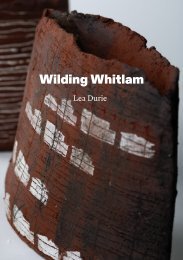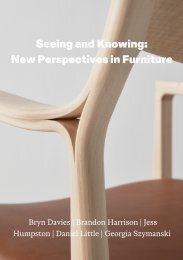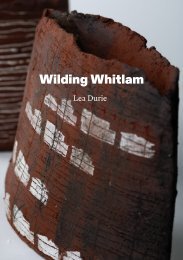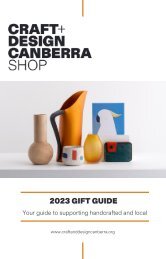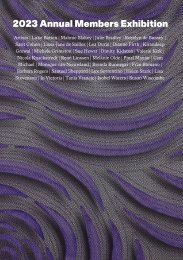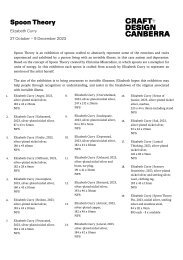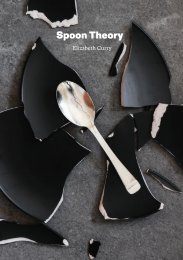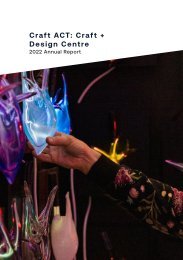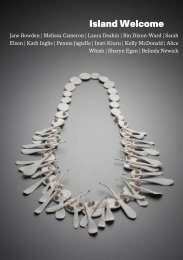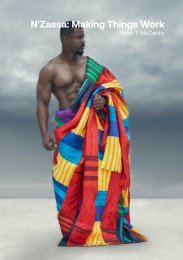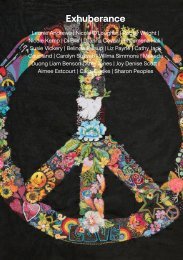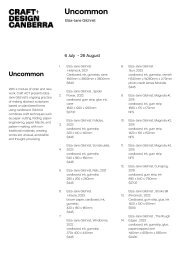2024 Emerging Contemporaries Exhibition Catalogue
Create successful ePaper yourself
Turn your PDF publications into a flip-book with our unique Google optimized e-Paper software.
<strong>Emerging</strong><br />
<strong>Contemporaries</strong><br />
Adelaide Butler | Alexander Sarsfield | Alicia Cox |<br />
Beth O'Sullivan | Claudia Vogel | Jacky Lo | Jacqui<br />
Keogh | Justin Wasserman | Kate Shaw | Kirrily<br />
Jordan | Leanne McKenzie | Matt Walker
Craft + Design Canberra is partially supported by the ACT<br />
Government, the Visual Arts and Craft Strategy - an<br />
initiative of the Australia State and Territory Governments,<br />
and the Australia Council for the Arts - the Australian<br />
Government's arts funding and advisory body.<br />
Craft + Design Canberra acknowledges the Ngunnawal<br />
people as the traditional custodians of the ACT and<br />
surrounding areas. We honour and respect their ongoing<br />
cultural and spiritual connections to this country and the<br />
contribution they make to the life of this city and this<br />
region. We aim to respect cultural heritage, customs, and<br />
beliefs of all indigenous people.<br />
Craft + Design Canberra<br />
Wednesday - Saturday | 12pm - 4pm<br />
Or by appointment.<br />
Level 1, North Building | 180 London Circuit<br />
Canberra ACT Australia<br />
02 6262 9333<br />
www.craftanddesigncanberra.org<br />
Publisher: Craft + Design Canberra<br />
Coordination: Waratah Lahy<br />
Graphic Design: Belinda Neame<br />
ABN 33 314 092 587<br />
© Craft + Design Canberra<br />
Cover Image: Alexander Sarsfield | Māu, Māku (one for you, one for me) | Detail. 2023 | Photo: Brenton McGeachie
<strong>Emerging</strong><br />
<strong>Contemporaries</strong><br />
Adelaide Butler | Alexander Sarsfield | Alicia Cox | Beth O'Sullivan |<br />
Claudia Vogel | Jacky Lo | Jacqui Keogh | Justin Wasserman | Kate<br />
Shaw | Kirrily Jordan | Leanne McKenzie | Matt Walker<br />
16 February - 16 March <strong>2024</strong><br />
Craft + Design Canberra
Image: Adelaide Butler | ‘Altogther Trifling Matters’, 2023 | Photo: Jack Black
Image: Matt Walker | Liquor Locker (detail), 2023 | Photo: Daniel Mulheran
Image: Alicia Cox | Ostensibly Equal, 2023 | Photo: Courtesy of the artist
<strong>Emerging</strong> <strong>Contemporaries</strong><br />
<strong>Exhibition</strong> Statement<br />
<strong>Emerging</strong> <strong>Contemporaries</strong> is Craft + Design<br />
Canberra’s national award exhibition for early<br />
career artists. <strong>Emerging</strong> <strong>Contemporaries</strong><br />
features the works of emerging designers and<br />
makers from local education institutions<br />
including Sturt School for Wood, Canberra<br />
Potters Society, Canberra Institute of<br />
Technology, and the ANU School of Art +<br />
Design.<br />
This exhibition plays a pivotal role in supporting<br />
and transitioning artists into professional<br />
practice.
Image: Kirrily Jordan | Sextillion ways to kneel and kiss the ground, 2023 | Photo: Brenton McGeachie
Image: Justin Wasserman | Red Arch, 2023 | Photo: Courtesy of the Artist
Making Connections<br />
<strong>Exhibition</strong> Essay<br />
<strong>Emerging</strong> from the shadow of the pandemic<br />
years, <strong>2024</strong>’s crop of artists, designers and<br />
makers represents a return to connection,<br />
evidenced by a focus on tactility,<br />
communication, and co-creation. What we<br />
haven’t returned to is a world we recognise, and<br />
the artists selected for this exhibition utilise a<br />
variety of strategies, techniques and<br />
craftsmanship to grapple with issues both<br />
timeless and timely.<br />
What very much unifies the works in <strong>Emerging</strong><br />
<strong>Contemporaries</strong> is excellence in making. The<br />
restoration of intensive studio practice in art and<br />
design schools can be seen in the seamless<br />
combination of mixed woods and metal in the<br />
modular sofa/chaise/chair construction of<br />
Claudia Vogel. Matt Walker’s Liquor Locker, a<br />
wooden drinks cabinet for the inebriated, has<br />
had its harsh edges removed ‘for the safety of the<br />
user’. One can imagine that though its<br />
inspirations are hot dogs and popsicle sticks, it is<br />
a serious piece of work. Similarly, I can<br />
appreciate the precision and detail of Kate<br />
Shaw’s combination watercolour and<br />
screenprinted drawings. She works hard to<br />
create visual storytelling told through a careful,<br />
measured approach to abstract composition.<br />
Such labour can also help to expose hidden<br />
narratives. The act of stitching provides the<br />
somewhat pixelated effect of Adelaide Butler’s<br />
delicate portraits of Queen Elizabeth I, among<br />
other women, in the act of embroidery. These are<br />
in part products of digital fabrication; yet they<br />
are very pointed in their depiction of the process<br />
of the handmade. Intensive layered monoprints<br />
are worked and reworked to expose the forts of<br />
Justin Wasserman’s imagination.<br />
Touch is very much on the agenda of the ceramic<br />
works represented in this exhibition, whether<br />
that is Jacky Lo’s kintsugi renewal of a broken<br />
cup, Jacqui Keough’s Japanese wave-textured<br />
vases, or Alicia Cox’s dysfunctional domestic<br />
ware, glazed in high relief so as to render them<br />
possibly useless. They tell us stories about<br />
objects in our daily rituals, passions and<br />
relationships.<br />
A tactile, contoured surface can also be found on<br />
Reefinity, the unglazed clay works of Beth<br />
O’Sullivan. This now familiar visual language is<br />
an outcome of the process of 3D printing. Whilst<br />
the technique of printing ceramics has an<br />
inherent porosity, this property has been used<br />
as an advantage. Her innovative project<br />
communicates beyond the creative sphere to a<br />
decidedly different audience--endangered coral,<br />
coral polyps and the marine biologists charged<br />
with preserving them.<br />
The aspect of connection within and beyond the<br />
traditional arts audience leads into elements of<br />
co-creation at the core of the practices of Kirilly<br />
Jordan and Alexander Sarsfield. Each works<br />
within an indigenous textile language to reach<br />
different communities. For Sarsfield, the<br />
sharing of his Maori culture through weaving a<br />
fibre vessel and the conversation that takes<br />
place in that process is an exchange, and one in<br />
which he hasn’t always chosen easy partners<br />
with whom to do so. I see his project as one of<br />
taking risks for the sake of renewing and<br />
rebuilding relationships, an artistic model for<br />
reconciliation. Meanwhile, Jordan’s ongoing<br />
project to share transcultural weaving holds a<br />
multitude of voices and hands in the making of<br />
woven sculptural forms. This act of collective<br />
making decentres authorship, highlights<br />
ingenuity and celebrates community.<br />
These artists are exploring the vital edges of<br />
materials and meaning; their works underscore<br />
the ongoing relevance of craft and design in the<br />
contemporary world. I hope that this promising<br />
array of approaches is indicative of the creative<br />
practice to come from these emerging voices.<br />
Jefferey Sarmiento
BIO<br />
Dr Jeffrey Sarmiento is a glass artist and Senior<br />
Lecturer at the School of Art and Design at the<br />
Australian National University, where he is Head<br />
of Glass. Previously he was Associate Professor<br />
in Glass at the University of Sunderland, UK,<br />
where he completed a PhD in 2011. Educated at<br />
the Rhode Island School of Design, he has also<br />
been a Fulbright Fellow in Denmark. He has<br />
taught workshops on glass and print<br />
internationally, from Pilchuck Glass School in<br />
the USA to China Art Academy Hangzhou and<br />
UCOL in New Zealand.<br />
Known for his creative practice exploring<br />
cultural identity and the graphic image in glass,<br />
Sarmiento embeds layers of information in his<br />
intricately constructed kiln-formed objects,<br />
sculptures, and public commissions. He won the<br />
International Glass Prize at Glazenhuis, Belgium,<br />
and his 2013 solo exhibition at National Glass<br />
Centre in Sunderland toured to the US. His<br />
collaborative work was included in Glasstress at<br />
the 56th Venice Biennale, and recently showed<br />
with Bullseye Projects in Passage at the Byre, an<br />
alternative art space in the Scottish Highlands.
Image: Beth O’Sullivan | Untitled 1, 2023 | Photo: Courtesy of the Artist
Image: Adelaide Butler | “She occupies her time most with the needle. – Anna of Kleve”, 2023 | Photo: Jack Black
Adelaide Butler<br />
ARTIST STATEMENT<br />
ARTIST BIOGRAPHY<br />
How do we understand early modern english<br />
women today, over 400 years later and on the<br />
opposite side of the world? Their histories are<br />
constantly shaping our lives, and our current<br />
perceptions change the way we look back<br />
through time. So how can we ensure that their<br />
history is not relegated to irrelevance, nor<br />
blindly celebrated through nostalgia?<br />
The early modern women’s embroidery<br />
practices, long overlooked and ignored, have<br />
been reimagined as their portraits come<br />
together, stitch by stitch, to animate the motion<br />
of sewing. Through the embodied act of<br />
stitching, their stories are carried into the<br />
present.<br />
Adelaide Butler is an emerging interdisciplinary<br />
artist currently living and working between<br />
Ngunnawal and Wurundjeri Country. Her work<br />
explores how we understand the past in a<br />
contemporary context through a feminist lens;<br />
centring women’s narratives, particularly in<br />
domestic spaces. Adelaide recently graduated<br />
with a Bachelor of Arts / Bachelor of Visual Arts<br />
(Honours) from the Australian National<br />
University.<br />
She has had the privilege of exhibiting at major<br />
Australian institutions including the National<br />
Gallery of Victoria as well as in international<br />
exhibitions.<br />
Image: Adelaide Butler | “In her moment of triumph. – Elizabeth Tudor”, 2023 | Photo: Brenton McGeachie
Image: Alexander Sarsfield | Māu, Māku (one for you, one for me), 2023 | Photo: Brenton McGeachie
Alexander Sarsfield<br />
ARTIST STATEMENT<br />
This project arose through a conscious effort to<br />
bridge my time spent divided between Māori and<br />
Australian cultures. I welcomed exposure,<br />
inviting any and every question. Ancestral<br />
traumas, my opinions on death, and what were<br />
traditionally used instead of bobby-pins, were all<br />
on the table. In episodes of co-creating, I found<br />
renewed opportunities for cultural continuation,<br />
cultural sharing, and cultural belonging within<br />
an urban Australian culture.<br />
The exchanges presented, extend beyond a mere<br />
conversation. Each iteration of making is a<br />
tangible acknowledgment of my whakapapa. A<br />
navigation of living a Māori identity where most<br />
of my connections cannot pronounce my<br />
ethnicity. In orchestrating my own vulnerability,<br />
I seek to bridge this dual identity and build of<br />
community. With a reciprocated sharing of<br />
experiences and mutual decision-making, the<br />
other person’s input shapes my outcome. These<br />
belongings hold these interactions.<br />
ARTIST BIOGRAPHY<br />
Alexander Sarsfield is of Ngāi Te Rangi and<br />
Ngāti Hako descent, and lives on Ngunnawal<br />
and Ngambri Country. Centering his practice<br />
around a reflexive process, Alex dabbles across<br />
crafts to delve into various aspects of<br />
sociocultural identity and interpersonal<br />
relationships. More recently, he has been<br />
learning Māori techniques of making to enjoy<br />
both a community and research-based practice.<br />
Alex recently graduated from the Australian<br />
National University with a Bachelor of Science<br />
(Psychology) and a Bachelor of Visual Arts. Alex<br />
was awarded the M16 Artspace Drawing Prize<br />
2023 and the M16 Artspace Local Artist Award<br />
for the same prize.<br />
This year, he is looking forward to presenting<br />
solo exhibitions in the Goulburn Regional Art<br />
Gallery and Tuggeranong Arts Centre, awarded<br />
as part of the <strong>Emerging</strong> Artist Support Scheme.
Image: Alicia Cox | Pink Cup and Saucer, 2023 | Photo: Courtesy of the artist
Image: Beth O’Sullivan | Vor, 2023 | Photo: Brenton McGeachie
Beth O’Sullivan<br />
ARTIST STATEMENT<br />
Reefinity is an transdisciplinary research project<br />
investigating material science (ceramic<br />
technology), ecology, digital design, and<br />
manufacturing. Through rethinking the<br />
relationship between these fields, Reefinity aims<br />
to support marine biology research by focusing<br />
on the needs of corals (and coral polyps), such as<br />
the composition and topographies of the material<br />
they settle on.<br />
Computational design and 3D-printing (digital<br />
fabrication) was explored alongside more<br />
traditional ceramic forming technologies to<br />
investigate ways that digital design approaches<br />
could enhance data collection from settlement<br />
forms used in the research process. A proof-ofconcept<br />
design model and prototypes are<br />
presented, ideal for up-scaling and for further<br />
exploration in the laboratory and field.<br />
ARTIST BIOGRAPHY<br />
Beth is a transdisciplinary designer based in<br />
Canberra (Ngunnawal and Ngambri country)<br />
and Sydney (Gadigal Country), Australia. She<br />
works at the intersection of design, ecology and<br />
emerging technologies.<br />
With a background in ecology and<br />
environmental science, her work focuses on<br />
critically analysing the relationships and<br />
connections between human and non-human<br />
species, with a focus on novel, environmentally<br />
conscious materials.
Image: Claudia Vogel | Adapt A Bench, 2023 | Photo: Lefika Images
Claudia Vogel<br />
ARTIST STATEMENT<br />
I designed this piece to be more than just a<br />
bench. Its functionality is much wider: in<br />
addition to being a comfortable two-seater<br />
bench, the two removable backrests (stored<br />
under the bench seat) convert the bench into a<br />
chair, or two chairs, or a chaise lounge.<br />
The bench is also wider than usual: ideal to lie<br />
back on. Its rounded corners and edges, with<br />
matching cylindrical legs, enhance its look of<br />
comfort. It is intended to be ideal in an<br />
apartment, where space is typically limited and a<br />
multi-functional piece of furniture is particularly<br />
useful.<br />
ARTIST BIOGRAPHY<br />
Claudia Vogel is an emerging furniture designer<br />
and maker who is currently based in Sydney on<br />
Gadigal County. In her designs, Claudia<br />
embraces contemporary functionality with<br />
uniqueness. Often the pieces are multifunctional<br />
and modular. Her pieces are clear in<br />
their function but have surprising elements that<br />
tweak the interest of the viewer or user, to make<br />
the pieces refreshing and more memorable.<br />
International design influences are also<br />
sometimes evident, particularly Japanese and<br />
Scandinavian influences.<br />
Her work always puts the beauty of one or more<br />
species of wood on full display, including<br />
through visible joinery techniques. Claudia has a<br />
Bachelors of Industrial Design from University<br />
of Technology Sydney. Following that degree,<br />
she realised that she had a particularly strong<br />
interest in designing and creating in wood. She<br />
has recently completed a one-year full-time fine<br />
furniture woodworking course at the Sturt<br />
School for Wood in Mittagong.
Image: Jacky Lo | Petal Cup with Kintsugi, 2023 | Photo: Courtesy of the Artist
Jacky Lo<br />
ARTIST STATEMENT<br />
In my journey of crafting practical ceramics, I<br />
discover beauty in imperfections. Influenced by<br />
the Japanese repairing technique - Kintsugi, I<br />
intentionally embrace the defects in each piece,<br />
considering them integral parts of its narrative<br />
rather than flaws.<br />
Using traditional Kintsugi methods, I mend<br />
broken ceramics with Japanese lacquer, treating<br />
the process as a metaphor for life's journey. The<br />
golden seams, where repairs take place,<br />
symbolize resilience, strength, and the<br />
transformative power of healing. This fusion of<br />
function and art transforms imperfections into a<br />
visual story of renewal, celebrating the beauty in<br />
the imperfect perfections of our daily lives.<br />
ARTIST BIOGRAPHY<br />
Jacky, a potter hailing from Hong Kong, is the<br />
creative force behind the pottery studio known<br />
as 'Everything Flows.' Together with his partner<br />
Celine, they form a dynamic duo dedicated to<br />
the art of pottery. The name of their studio,<br />
'Everything Flows,' is a testament to Jacky's<br />
profound belief in the interconnectedness and<br />
perpetual motion inherent in all aspects of life—<br />
a philosophy that mirrors the elements of<br />
pottery: fire, clay, and water.<br />
Specialising in the creation of tableware, Jacky<br />
pours his passion into crafting pieces that are<br />
not only beautiful but also practical for everyday<br />
use. His attention to detail and commitment to<br />
quality are evident in every object he makes,<br />
with each one reflecting his design philosophy<br />
and approach to his own aesthetic.<br />
Influenced by Japanese pottery, Jacky infuses<br />
his work with personal experiences and<br />
emotions, creating uniquely authentic pieces.<br />
Each creation embodies Jacky's artistic journey,<br />
showcasing his profound connection to the craft.
Image: Jacqui Keough | Dark Wave Vase Series, 2023 | Image Courtesy of Artist
Jacqui Keogh<br />
ARTIST STATEMENT<br />
This series of 5 ceramic vases entitled 'Dark<br />
Wave' features wheel thrown and hand<br />
decorated black mid-fired clay. The vessels are<br />
an exploration of making two part pieces and<br />
are informed by traditional shapes. The surface<br />
designs are the result of ongoing<br />
experimentation with surface patterning using<br />
found implements. The waves reference the<br />
traditional Japanese wave motif or Seigaiha and<br />
express part of my identity associated with<br />
living for many years beside the ocean and<br />
almost daily time atop it, paddling ocean surf<br />
skis and surfboat rowing.<br />
The wave pattern flows effortlessly, changing<br />
direction and size as does the ocean's surface.<br />
The gold elements in my series were initially an<br />
instinctive reaction to many suggestions that<br />
my artist initials were too dominant. I decided<br />
to 'lean into' the reaction and 'go for gold'. Over<br />
time my block signature has evolved and is a<br />
bold statement about unapologetically claiming<br />
space. The gold spots are just pretty and who<br />
doesn't like a 'bit of bling'?<br />
ARTIST BIOGRAPHY<br />
Jacqui Keogh Ceramicist, Member Canberra<br />
Potters Society and Craft and Design ACT.<br />
Jacqui Keogh is a ceramic artist working from<br />
her home studio in Narrabundah, ACT. She has<br />
been practicing ceramics for four years and<br />
creates unique wheel-thrown and hand<br />
embellished everyday functional forms. In a<br />
world of the mass-produced, she celebrates the<br />
‘hand made’ and ‘slow’ in her products. Each<br />
piece is individually and lovingly crafted,<br />
intentionally retaining throwing lines, remnant<br />
drips and splashes incurred during glazing or<br />
firing and not perfect finishes. Much of her<br />
work is hand embellished or decorated and no<br />
batch is ever quite the same.<br />
An affinity with the natural environment is<br />
reflected in her making. Her choices of clays,<br />
surface decoration and glazes are inspired by the<br />
beautiful hues of the river mouth, beach and<br />
ocean at Pambula Beach where she lived for<br />
many years. She recycles all her clay and fires<br />
with an electric kiln for sustainability and<br />
practicality. Using the electric kiln has been a<br />
catalyst for exploring distinctive decorating<br />
styles, surfaces and glazes that can be created in<br />
a mid-fire environment. As a result the works<br />
‘give back’ something of herself and are imbued<br />
with a captivating aesthetic.
Image: Justin Wasserman | Fort Golden II, 2023 | Photo: Courtesy of the Artist
Justin Wasserman<br />
ARTIST STATEMENT<br />
This work presents a series of imagined<br />
fortresses. The form of the fortress is abstracted<br />
and reduced to a symbol which is repeated - with<br />
variations - across the series. Within the<br />
constraints of this refined form I draw<br />
inspiration for experimenting with line, texture<br />
and colour. The multi-plate monoprint technique<br />
offers endless opportunities for playing with the<br />
interactions between layers of colour; alternately<br />
hiding and revealing layers of mark-making.<br />
ARTIST BIOGRAPHY<br />
Justin is a Canberra-based emerging artist with a<br />
focus on drawing and printmaking. Justin was<br />
born in Zimbabwe and moved to Australia in 1988.<br />
He grew up in Perth before moving east to<br />
Canberra to work in the public service. Justin<br />
works from simple ideas influenced by art,<br />
literature and lived experience, which he then<br />
pushes as far he can into abstracted forms.
Image: Kate Shaw | Gilded Control, 2023 | Photo: Paul Murray
Kate Shaw<br />
ARTIST STATEMENT<br />
This body of work revolves around the<br />
integration of watercolour and fine detail<br />
overdrawing. Each piece is a calculated<br />
exploration of balance and technique. The choice<br />
of watercolour serves as a foundation, allowing<br />
for nuanced gradations and soft transitions. This<br />
fluidity sets the stage for the subsequent<br />
application of ink or screen print, where<br />
precision and detailing come into play.<br />
For these works, the decision to incorporate fine<br />
detail is driven by a desire to elevate the visual<br />
impact of the work. It serves as a deliberate<br />
departure from the inherent translucency of<br />
watercolour, introducing structure and definition<br />
to the composition. The overlay of details serves<br />
not only to enhance associations and deepen<br />
narrative resonance, but also to softly convey<br />
elements of lived experience.<br />
ARTIST BIOGRAPHY<br />
Kate is an emerging visual artist using painting,<br />
drawing and printmaking as her main vehicles<br />
of communication. Kate was born and raised in<br />
Canberra and moved to Melbourne in 2010 to<br />
continue a career in the public sector. She<br />
relocated back to Canberra a few years ago to be<br />
closer to family.<br />
Kate has always enjoyed the arts and design and<br />
was drawn to restart her creative practice after<br />
her children started primary school. She<br />
commenced studying a Diploma in Visual Arts<br />
at CIT, and has recently graduated.<br />
The motivation behind this approach lies in the<br />
pursuit of visual storytelling. By combining the<br />
subtleties of watercolour with the crispness of<br />
ink, I aim to portray a harmonious coexistence of<br />
opposing elements. Each stroke is purposeful,<br />
contributing to the overall narrative of the piece.<br />
The hand is evident in the precision of the<br />
details, emphasising the deliberate decisions<br />
made throughout the creative process.
Image: Kirrily Jordan | Sextillion ways to kneel and kiss the ground, 2023 | Photo: Brenton McGeachie
Kirrily Jordan<br />
ARTIST STATEMENT<br />
Crafted by more than 250 people in Alice<br />
Springs/Mparntwe over ten transformative<br />
weeks, this playful work demonstrates the<br />
possibilities of human connection across<br />
generations, stories, languages, experiences, and<br />
beliefs.<br />
It celebrates the profound magic of collective<br />
making, with each thread an irreplaceable human<br />
story, and the merging of styles and colours into<br />
these organic forms becoming a tangible imprint<br />
of new relationships and deepening connections.<br />
Reflecting Rumi’s wisdom that there are a<br />
hundred ways to kneel and kiss the ground by<br />
offering the world what we love, the title<br />
venerates both the sacredness of the connections<br />
made and the joy interwoven in this piece. It<br />
references one moment among many – the<br />
infectious laughter that overtook the room when<br />
one young weaver, searching for a number bigger<br />
than a hundred, stumbled upon the word<br />
‘sextillion’ and couldn’t contain his delight.<br />
Beyond its playful facade the work is also<br />
intensely political. It recognises all making as a<br />
relational act rather than the imagined domain of<br />
the individual, and reflects deep faith in our<br />
interbeing as a path to both personal happiness<br />
and planetary healing.<br />
ARTIST BIOGRAPHY<br />
Kirrily Jordan is a multi-disciplinary artist<br />
working for social change. With a practice in<br />
weaving, textiles and socially-engaged arts,<br />
Kirrily creates projects that connect people to<br />
each other, rekindle their joy and challenge the<br />
epidemic of alienation. She firmly believes in the<br />
role of art in wellbeing, and sees collective<br />
making an essential tool in building ‘the more<br />
beautiful world our hearts know is possible’ –<br />
where people are grounded in themselves, deeply<br />
connected, and kind to each other.<br />
Kirrily holds a Bachelor of Design Arts, majoring<br />
in textiles, from the Australian National<br />
University and a PhD on cultural heritage from<br />
the University of Technology, Sydney. She has<br />
learnt basket weaving from skilled non-<br />
Indigenous and First Nations practitioners, and<br />
practices styles either from her own ancestral<br />
traditions (the British Isles) or with permission<br />
from her teachers. She is keenly interested in the<br />
transmission of weaving techniques around the<br />
world and how this continues to be shaped by<br />
processes of colonisation and globalisation.<br />
Kirrily’s projects have received funding from<br />
state, territory and Commonwealth agencies, and<br />
this project was assisted by the Australian<br />
Governments Regional Arts Fund, which<br />
supports the arts in regional and remote<br />
Australia. Kirrily has delivered award-winning<br />
creative workshops in Canberra and nationally<br />
since 2018.
Image: Leanne McKenzie | Garden Totems, 2023 | Photo: Courtesy of the Artist
Leanne McKenzie<br />
ARTIST STATEMENT<br />
Garden Totems explores my interest in gardens and reflects<br />
my passion for both art and nature. My works add pops of<br />
colour to outdoor spaces and some also serve a functional<br />
purpose by providing a reservoir for bees to drink. This dual<br />
functionality adds an interesting and environmentally<br />
conscious dimension to my work. I enjoy making a variety of<br />
clay beads using a range of clays, underglazes and glazes<br />
assembled onto metal rods to create my striking garden<br />
totems. Some of the totems may have solid pops of colour,<br />
whilst on others I experiment with surface decoration of<br />
applying floral embellishments, piped porcelain beading or<br />
different glaze applications.<br />
ARTIST BIOGRAPHY<br />
Leanne McKenzie is a primary school teacher living on<br />
Ngunnawal / Ngambri Country. Most of her life she has<br />
dabbled with artistic expression through drawing and<br />
painting. She has a passion for exposing young children to<br />
creative endeavours and received training through the<br />
National Portrait Gallery in Visual Thinking Strategies. This<br />
professional development nurtured Leanne’s abilities to<br />
expose her students to develop deep looking and thinking<br />
towards artistic imaginary. Activities such as this support<br />
children’s skills in creative thinking as well as in literacy<br />
development.<br />
In recent years Leanne began developing her own artistic<br />
practice working with clay. Her exploration of pottery and<br />
focus on creating items for sculptural interest in gardens<br />
reflects a passion for both art and nature. The fact that<br />
Leanne engages with various art communities such as<br />
Stonecrest Creations in Murrumbateman, Canberra Potters<br />
Society in Watson and Laughing Frog Studio in Gundaroo<br />
demonstrates her commitment to honing her craft and<br />
learning from different sources. Embracing pottery whilst<br />
working full time as a teacher indicates a continuous journey<br />
of self-discovery and artistic exploration.
Image: Matt Walker | Liquor Locker, 2023 | Photo: Daniel Mulheran
Matt Walker<br />
ARTIST STATEMENT<br />
Extruded through the floor, Liquor Locker is a<br />
whimsical bar cabinet resembling something<br />
along the lines of a high school locker, a paling<br />
fence, a handful of paddle pop sticks or a packet<br />
of hot dogs. Harsh edges have been removed for<br />
safety of the user, with rounded playful shapes<br />
emerging at every opportunity. No bar should<br />
fight back as you stumble over for one last drink.<br />
ARTIST BIOGRAPHY<br />
This past year has taught me why the<br />
conventions of woodwork are the way they are—<br />
cell structure, wood movement and tools<br />
available point towards a certain language of<br />
design and craft, honed over thousands of years<br />
to tame wood. Yet, I like to think I bring a<br />
certain amount of arrogance and irreverence<br />
with my design process. I get a kick out of<br />
pausing at every stage to consider the most<br />
logical way to approach something, refusing to<br />
accept it, and running in the other direction.<br />
Why not? If I can dunk it in stain from<br />
Bunnings, torture it with fire and gas, or give it<br />
little red tits, I can’t help myself.<br />
Perhaps wood is even more stubborn than I am.<br />
But best believe—mother knows best—I’ll have<br />
my way with him.




